The power of the woman
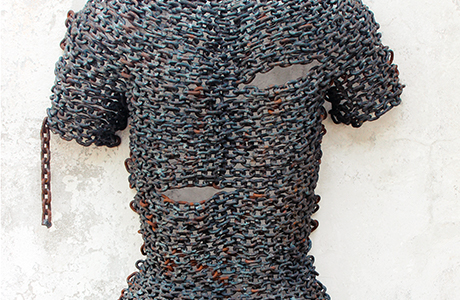
Freddy Tsimba (1967), Dos (Back), no. 999. 2016. Chains. Private collection.
In here, one senses the essence of that particular power of womanhood in which Freddy Tsimba has such faith. His tireless portrayal of how this power is stifled haunts his work. For him, it may well be the only way of redeeming the Being. (In Koli Jean Bofane)

Freddy Tsimba (1967), Femme-ciseaux (Scissor woman). 2017. Scissors collected from hospitals. Galerie Angalia, Paris. Photo © Galerie Angalia.
Meanwhile, since the dawn of the 21st century, women’s bellies have been sacrificed, in the RD Congo, for the conquest of strategic minerals, through systematic rape and mutilation, to promote the extraction of the materials of the future. (In Koli Jean Bofane)
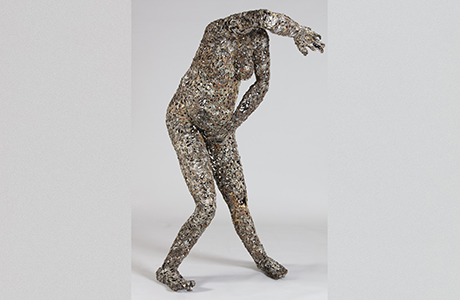
I will not give them my diamond 2014. Scrap materials, found keys. Collection Gervanne and Matthias Leridon. Photo © Mathieu Lombard. Courtesy Collection Gervanne and Matthias Leridon.
Part of a series of 9 terracotta busts, first exhibited in Belgium in 2004, in Herve. Freddy Tsimba engages in wordplay. In Lingala, ‘mabele’ has two meanings: the earth, and the breasts (libele in the singular).
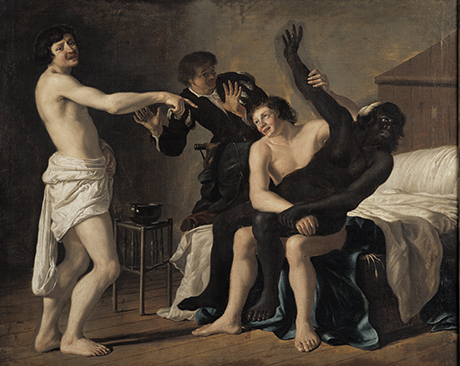
‘I was deeply marked by my encounter with this painting. The painting known as The Rape of the Negro Girl shows a defenseless black woman being raped. Her cry is left hanging. Couwenbergh’s work reflects the Europe of the 17th century. It is the triumph of the impunity of this bourgeoisie whose power lies in sexual supremacy and an imagined superiority. The painting inspired the creation of the two works The Forgotten’s Tears and I will not give them my diamond’ (Freddy Tsimba).
Christiaen van Couwenbergh (Delft, 1604-Keulen, 1667). Three Young White Men and a Black Woman, known as The Rape of the Negro Girl). 1632. Oil on canvas, 105 x 127.5 cm. Musée des Beaux-Arts de Strasbourg. Photo © Musées de Strasbourg.
Les statuettes exposées, les dos des femmes, possèdent une puissance visible. Des scarifications profondes peuvent y figurer. Malgré le travail minutieux du sculpteur ou du scarificateur, les dos demeurent dans une posture de fermeté. Les dos sculptés par Freddy Tsimba renvoient à cette puissance qui se prolonge par la nuque qui, elle, porte la tête sur lequel un colis est posé. (In Koli Jean Bofane)
Des sculptures faites de douilles, de cartouches et autre matériel de récupération, font face à de traditionnelles représentations de mères à l'enfant des collections du musée.
Face-à-face
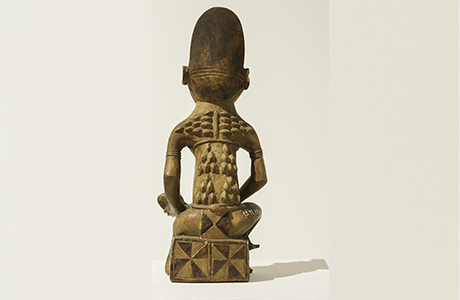
Mother-and-child figure. Kongo central, RD Congo. [Yombe]. Before 1955. Wood, pigments, glass. Gift from M. Valcke, 1955. EO.1955.98.40, collection RMCA Tervuren ; photo J.-M. Vandyck © RMCA Tervuren.
The phemba maternity figure depicts a mother-and-child pairing sculpted from wood or soapstone. It symbolises multiple births, fecundity, female fertility, continuation of the lineage, and survival of the community. Aside from the notion of procreation, the maternity figure is a powerful symbol of wealth, clan prestige, and reincarnation of an ancestor. She is used in rituals, fertility cults, divination, funerals, and political power.
A phemba maternity figure shows the mother in a number of positions: legs crossed, kneeling, squatting, seated, or standing, with the child on her lap, in her arms, on her hip, shoulder, or back. Each position has a specific cultural meaning.

Ndona Nkento. Mother-and-child figure. Kongo central, RD Congo. [Yombe]. Before 1977. Wood, pigments. Purchase from F. Van Noten, 1977. EO.1976.77.1, collection RMCA Tervuren ; photo J. Van de Vyver © RMCA Tervuren.
The Ndona Nkento maternity figure depicts the tutelary female ancestor, foundress of the line, and guardian of the secrets of power. She recalls the privileged social status of women in the matrilineal system. Associated with political power, she is used as a dignitary’s insignia.
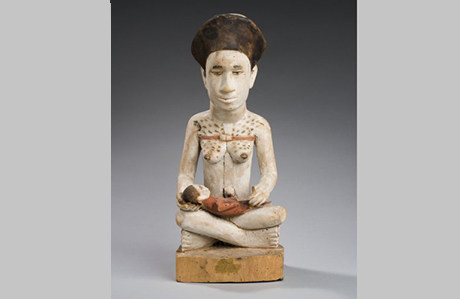
Mother-and-child figure. Mayumbe, Kongo central, RD Congo. [Yombe]. Before 1910. Wood, kaolin, black pigment, red pigment. Collected by Vankerkhoven, before 1909. EO.0.0.1040-1, collection RMCA Tervuren ; photo J. Van de Vyver © RMCA Tervuren.
Mother-and-child figure painted in white kaolin, an allusion to the ideal mother — one who becomes a fertile spouse, gives life, raises her child. She also represents a mother who would have given birth after undergoing a fertility ritual. The ritual white colour also implies the colour red. White symbolises purity, while red symbolises the bravery of childbirth, the transformation which confers a privileged status to the woman.